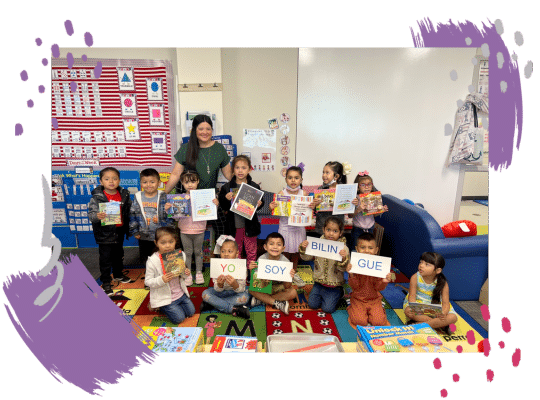
Find Texas Schools and Independent School Districts

Find Texas Schools and Independent School Districts

ESL Family Parent Liaison, Mrs. Montiel from Brazosport ISD, spoke to bilingual students.
Dual language programs create a balanced environment where native English speakers and speakers of another language, such as Spanish or Mandarin, learn together. Students receive instruction in both languages, promoting bilingualism, biliteracy, and cross-cultural understanding. Certified teachers guide both academic and language development.

Families choose dual language and bilingual education programs for many reasons:
Bilingual education differs from dual language programs in that instruction is conducted primarily or entirely in the student’s native language. Bilingual education supports English learners by helping them build a strong foundation in their first language while gradually developing English proficiency.
Programs like Spanish immersion are designed so that English speaking students can become fluent in Spanish. Students might enter in first grade where 90% of the instruction and interactions are conducted in English.
As students progress through school, the percentage taught in Spanish increases. By the time the student moves on to middle school, they are fluent in Spanish. Some public schools also offer French or Mandarin immersion programs.

UTSA hosted and invited South San Antonio ISD teachers and staff to its Bi-annual Bilingual Awards.
Other programs that provide students an opportunity to expand their dual language skills include study abroad. Study abroad scholarships help offset the cost of travel to another country such as Spain, France, or Italy.
Q1: What are Dual Language programs in public schools?
A: Dual Language programs use two languages—typically English and Spanish—to teach academic content. Students develop fluency in both languages while meeting academic standards.
Q2: What is the difference between Dual Language and Bilingual programs?
A: Bilingual programs primarily support students whose first language isn’t English by providing instruction in both English and their native language. Dual Language programs serve both English and non-English speakers to become bilingual and biliterate.
Q3: Who can enroll in a Dual Language or Bilingual program?
A: These programs are available to English Learners and, in many districts, also to English-proficient students who want to become bilingual. Availability varies by district and school.
Q4: What are the benefits of Dual Language education?
A: Students gain fluency in two languages, perform well academically, and develop cross-cultural awareness. Research shows they often outperform monolingual peers in the long term.
Q5: At what grade levels are Dual Language or Bilingual programs offered?
A: Many public school districts in Texas begin Dual Language or Bilingual education in Pre-K or Kindergarten and continue through elementary. Some programs extend through middle and high school.
Q6: Are these programs only for Spanish-speaking students?
A: No. Dual Language programs are designed for both English and Spanish speakers. Some districts also offer programs in other languages depending on community needs.
Q7: Will learning in two languages affect my child’s English skills?
A: No. Research shows that bilingual students often have stronger literacy and cognitive skills in both languages over time.
Q8: How do I enroll my child in a Dual Language or Bilingual program?
A: Contact your local public school district to learn about program availability, application windows, and eligibility. Most districts have dedicated language program coordinators.
Q9: Are Dual Language and Bilingual programs available in all Texas school districts?
A: While not every district offers them, many Texas public schools do. Check with your district to explore program options near you.
Bilingual education, dual language, and Spanish immersion programs are sought after by many parents, families, and students. Students reap valuable rewards from these programs.
In 1968, Congress mandated bilingual education with Title V11 of the Elementary and Secondary Education Act, also known as the Bilingual Education Act. The objective of bilingual education is to provide immigrants access to education in their primary or first language. The Bilingual Education Act has been amended to address issues like funding, training and academic support, and eligibility.
The U.S. Department of Education describes a bilingual education program as “an educational program for limited English proficient students.” The term, “limited English proficiency” describes an individual whose primary language is not English. Challenges in reading, writing, and conversation, and/or communication deny that person an opportunity to fully participate in society.

If you want to take advantage of this benefit or learn more about how a membership can help your organization please click the button below.